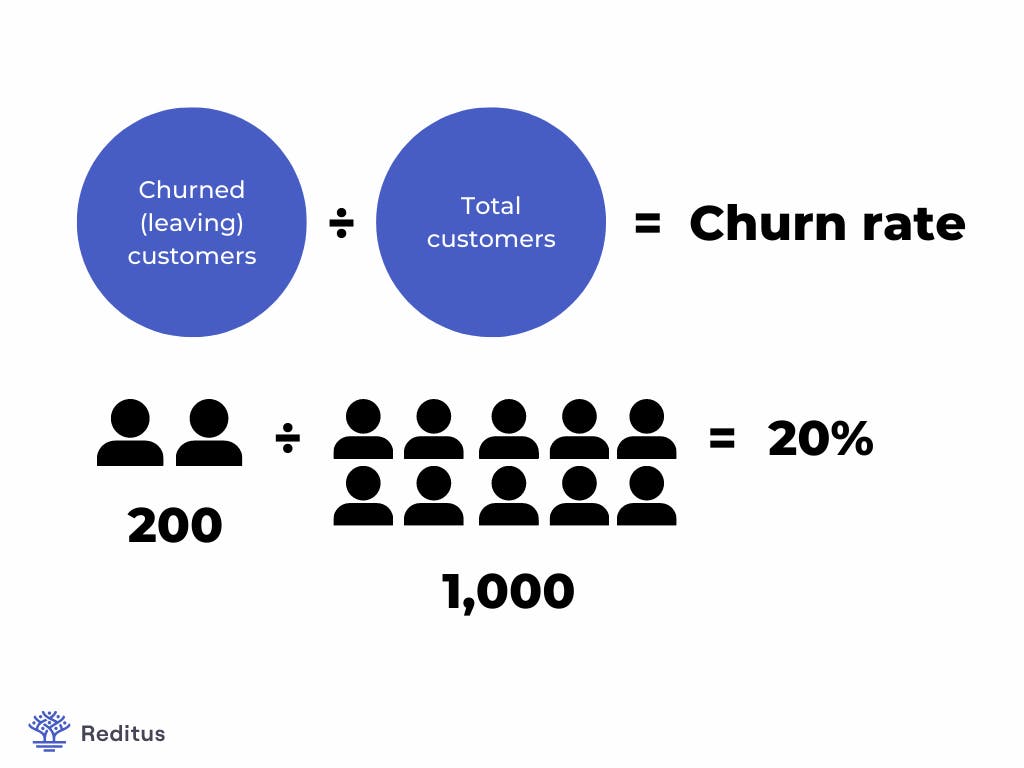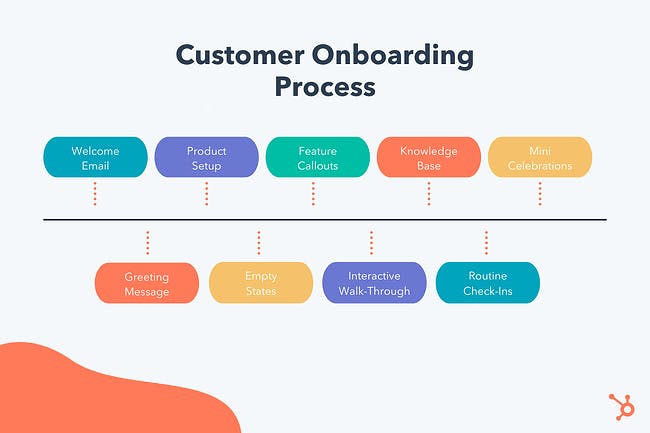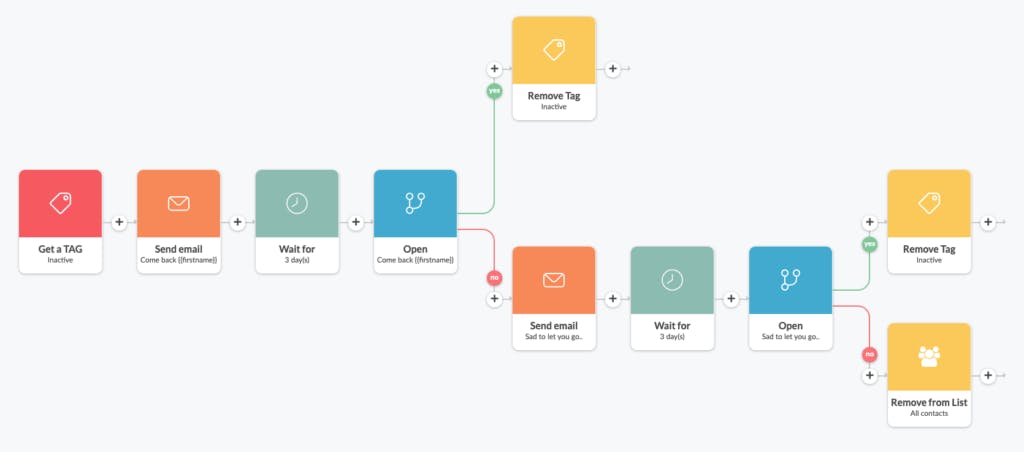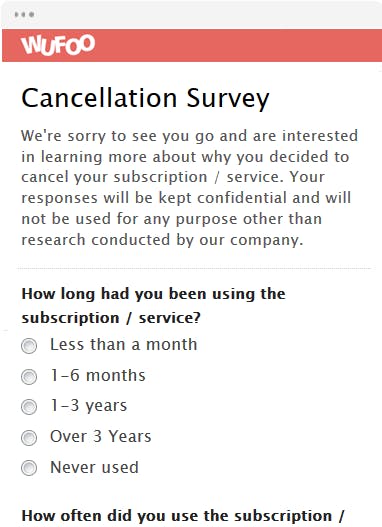8 Strategic Ways To Reduce Churn Rate in 2024

Churn rate certainly is the founder's nightmare. It means you've lost customers, potential revenue, and perhaps even brand loyalty.
As a result, it's one of the most important metrics to understand and manage. Reducing churn rate is critical for any business that wants to grow sustainably over time.
The million-dollar question is: How do you go about doing so?
In this post, we'll look at eight strategic ways for you to reduce your churn rate and keep your users happy.
Table of contents
- What Is Churn?
- Eight Strategies to Reduce Churn Rate in 2024
- 1. Create a positive onboarding experience
- 2. Send targeted messages
- 3. Personalize your messaging
- 4. Avoid rushing customers through the purchase process
- 5. Take advantage of product re-engagement email
- 6. Reduce your response times
- 7. Thank and reward loyalty
- 8. Use an exit survey to find out why customers left you
- Retention Doesn't Happen Overnight
What Is Churn?
Churn is the rate customers stop using a product, measured as a percentage. It's usually expressed as "churn rate," but you can also say "churn percentage."

Churn can be caused by many factors, including:
- Competition: Competitors introducing new products that are better than yours and seem more exciting than your existing offering.
- Interactions: A change in how consumers interact with your product—for example, if they rely on mobile instead of desktop or start using voice search instead of typing keywords into Google's search bar.
- Overall marketing effect: An advertising campaign that makes consumers think your offering is inferior to other options on the market (and therefore makes them less likely to choose it).
- More alternatives: An increase in competition from other companies that are offering similar products and services at a lower price point.
Or simply a change in consumer behavior that makes your offering less appealing.
For example, if consumers use mobile instead of desktop or voice search instead of typing keywords into Google's search bar.
If your product relies heavily on voice search functionality, that behavior change would've made your service less attractive.
Eight Strategies to Reduce Churn Rate in 2024
Now that you understand the basics of churn rate, let's explore a few strategies to decrease yours:
1. Create a positive onboarding experience
The first few weeks of a customer's journey with your product are critical to their long-term satisfaction and retention. They may leave your company if they don't have a positive experience during this period.
That's why it's essential to set up an onboarding strategy that helps them get acclimated quickly and easily—without making too many decisions or being overwhelmed by technical processes.
As a general rule, the more complex your product is, the longer it should take for users to get up and running. If you can simplify these processes, you're one step closer to reducing churn rate.

For example, if you're building complex software, you may want to include a video tutorial that walks users through the basics.
You can also use automated emails and prompts within the product to help them get started quickly and easily.
Ultimately, the goal is to reduce the time it takes for a new user to get started using your product. The less time they spend learning how it works, the more likely they will stick around and become active users.
2. Send targeted messages
There are three main ways to send messages:
- Onboarding emails
- Nurturing emails
- Reminders
The first two types of email are intended to educate your users about your product, while the last type is meant to remind them that you're still there and available should they need it.
The key is balancing these three factors:
- Make sure the content of your message is relevant,
- Don't send too many messages (or else they will get annoyed)
- Don't send too few (or else they may forget about you)
In addition, make sure not to use long paragraphs or complicated language in your messages.
Instead, opt for short sentences with bullet points that clearly explain what you want from them (the less time it takes for them to read through a message, the more likely it is that they'll read through all of it).
3. Personalize your messaging
Personalized messaging can be a powerful tool for reducing churn, but it can also be overwhelming and challenging to execute. The key is using your customer data to personalize your messages in a natural, not creepy, way.
Here's how it works:
First, identify attributes that indicate loyalty or the potential for loyalty.
For example, if a customer has been with you for five years and has purchased more than $50k of products during that time frame, they would be considered highly loyal (and thus valuable).
Next, figure out how best to segment customers into groups based on these attributes so that you can send targeted messages based on their circumstances and what stage they're at in the buyer's journey.
If someone is starting with your company, this might mean sending them an email explaining all the benefits of working with you versus competitors.
If someone already knows about your product but hasn't bought from you yet because they're concerned about price points or delivery dates, you could address these concerns by emailing how their needs will be met by working with yours instead.
4. Avoid rushing customers through the purchase process
If you rush customers through the sales process, they won't have enough time to fully understand what they're purchasing.
Rushing them through can also make your product seem like a low-quality option. Instead, give them plenty of time to consider all the details and ask questions if necessary.
This will help ensure they have the information they need before making a purchase decision.
Buyer's remorse is real, and it can be a big problem for you and your business.
If you don't give customers enough time to consider every aspect of their purchase, they may feel rushed into it and regret their decision later on.
This will hurt your customer retention rates in the long run because customers who feel like they made a wrong choice aren't likely to stick around for very long.
5. Take advantage of product re-engagement email
Email is the most effective channel for two reasons.
First, it's the most direct way to communicate with customers.
As a customer-centric business, you want to speak directly with your customers to build relationships and keep them coming back—which email allows you to do without interruption from other channels like Facebook or Twitter.
Second, email is the most cost-effective channel for reaching customers over time. If a customer signs up for your newsletter and gets an offer every week or so, there's no reason why that person shouldn't eventually convert into a paying customer.
That's because email allows you to connect with new leads and re-engage old ones which might have forgotten about your product altogether!
A re-engagement email sequence can help you decrease churn because it re-connects your customers with your brand, reminds them of the value they're receiving from you, and gives them the incentive to return.

A solid re-engagement sequence might include:
- A welcome email that gives the customer a basic overview of what you do and how they can get started with your product. This can be in the form of a blog post or an ebook.
- A follow-up email that answers any questions about the initial welcome email and introduces them to some of your other products/services.
- A re-engagement email every few weeks, which could contain exclusive content like blog posts, videos, or interviews
You might also consider setting up an automated sequence that sends emails after a certain amount of time has passed since their last purchase. This can help you re-engage customers who have already purchased from you but haven't been back in a while.
6. Reduce your response times
Customers' dissatisfaction with a slow-to-respond company is a significant cause of churn.
Customers who feel they are waiting too long for support are twice as likely to leave a business than those who don't have this issue.
Use chatbots, a help desk, or a live chat tool from Zendesk and other vendors that can be set up in minutes and provide 24/7 service without human intervention.
If you want to go even further, consider using an artificial intelligence bot that can solve common problems independently, freeing up real people for more complex issues.
7. Thank and reward loyalty
Once you have identified the customers who are likely to churn, you can begin to work on reducing their likelihood of doing so.
One of the most effective ways is by thanking them for their loyalty and rewarding them with discounts, coupons, and other incentives.
Here are some ideas for rewarding your most loyal customers:
- Send emails thanking them for using your product or service. This will help improve their perception of any negative experiences they may have had.
- Offer discounts on future purchases as an incentive to keep buying from you rather than switching to another provider.
You could also offer these incentives through a loyalty program that gives points every time they use your product or service; customers can later redeem them for rewards such as gift cards or merchandise with your company's logo on it (like t-shirts).
8. Use an exit survey to find out why customers left you
Asking why customers leave is one of the most important things you can do to avoid churn. Without this information, you won't know if any issues need to be addressed.

If you don't ask, you won't know.
There are many ways to collect exit survey data, and we recommend using a mix of them:
- Use email surveys in combination with your marketing automation system. This ensures that each customer receives an email asking them to complete the survey (which hasn't always been done before).
- Survey customers who have requested refunds or closed their accounts due to dissatisfaction with your product or service; this is known as "churn prevention research.
Your goal here is to learn more about why they left and get valuable insight into what could be improved upon before they depart permanently—and hopefully become a happy customer again!
Reducing Churn Rate: FAQs
What is the best way to reduce churn?
One of the best ways to reduce churn is by providing excellent customer service. This means taking the time to understand customer needs and responding quickly and proactively.
Additionally, offering customers incentives to stay, such as discounts and rewards, can help to reduce churn.
Finally, creating a solid loyalty program that rewards customers for their loyalty can help to reduce churn and encourage customers to remain.
What causes a high churn rate?
High churn rates can be caused by several factors, including poor customer service, a lack of loyalty programs, and a lack of incentives to stay.
Poor customer service can lead customers to feel like they are not being valued or heard, resulting in them leaving.
What is a reasonable churn rate?
A reasonable churn rate is lower than the industry average, typically around 5-7%.
A lower churn rate indicates that customers are satisfied and loyal to the brand and that the business is managing customer relationships well.
Is churn rate a KPI?
Yes, churn rate is a key performance indicator (KPI) for many businesses. It measures the rate at which customers leave or churn from a business and can be a strong indicator of customer satisfaction and loyalty.
High churn rates can indicate a need to improve customer service and loyalty programs.
In contrast, low churn rates can show that a business is doing an excellent job of managing customer relationships.
What is the difference between churn and turnover?
The main difference between churn and turnover is that churn measures the rate at which customers are leaving or “churning” from a business, while turnover measures the rate at which employees are leaving or “turning over” from a business.
Churn is a key performance indicator (KPI) that measures customer loyalty, while turnover is a KPI that measures employee satisfaction.
Both can be used to measure the success of a business, and both can indicate areas where improvement is needed.
Retention Doesn't Happen Overnight
A retention strategy isn't just about customer service and price; it's also about understanding your audience and knowing how to create a product or service that meets their needs.
With these strategies in mind, you'll be able to focus on your customers, keep them happy and engaged with your brand, and ensure they don't churn.
You can also use tools like HubSpot or Infusionsoft to make it easier for you to personalize your messaging, track the effectiveness of different channels like email or social media, and even create automated emails that go out automatically when someone leaves (or stays).
Ultimately, the best way to keep your customers happy and engaged is to be proactive about your customer service.
By staying up-to-date with the latest trends in customer service, you can ensure that no matter what changes happen in the marketplace, your brand will always know how to adapt and continue providing an amazing experience for everyone who interacts with it.

